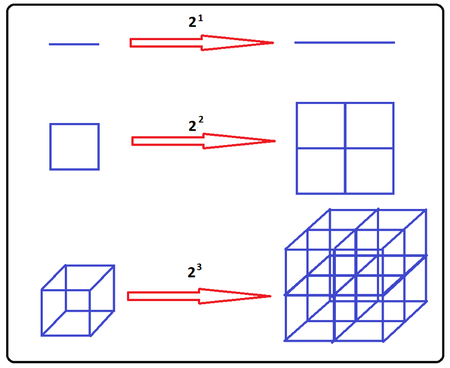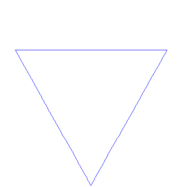| Line 27: | Line 27: | ||
* Quasi self-similarity: This means that the shapes are similar but slightly different in some way. In other words, the broccoli would be an example of Quasi self-similarity. Another example in mathematics would be the [[Walther_MA271_Fall2020_topic17#Madelbrot Set|Mandelbrot set]]. | * Quasi self-similarity: This means that the shapes are similar but slightly different in some way. In other words, the broccoli would be an example of Quasi self-similarity. Another example in mathematics would be the [[Walther_MA271_Fall2020_topic17#Madelbrot Set|Mandelbrot set]]. | ||
* Statistical self-similarity: If something has statistical self-similarity, the shape might not necessarily be similar, but the statistical properties of the smaller part are similar to that of the whole. This is the case with most things in the real world with self-similarity. | * Statistical self-similarity: If something has statistical self-similarity, the shape might not necessarily be similar, but the statistical properties of the smaller part are similar to that of the whole. This is the case with most things in the real world with self-similarity. | ||
| − | * Multifractal scaling: this is when the fractal or geometry can be characterized by more than one [[Walther_MA271_Fall2020_topic17#Fractal Dimension|fractal dimension] (mentioned later). | + | * Multifractal scaling: this is when the fractal or geometry can be characterized by more than one [[Walther_MA271_Fall2020_topic17#Fractal Dimension|fractal dimension]] (mentioned later). |
===== <small>Infinitely Detailed</small> ===== | ===== <small>Infinitely Detailed</small> ===== | ||
| Line 49: | Line 49: | ||
Here is a great video to understand fractal dimension and how it can be calculated: [https://www.youtube.com/watch?v=gB9n2gHsHN4 Fractal Dimension Explanation].<br /> | Here is a great video to understand fractal dimension and how it can be calculated: [https://www.youtube.com/watch?v=gB9n2gHsHN4 Fractal Dimension Explanation].<br /> | ||
| − | + | The last common characteristic of fractals is having a fractal dimension that is greater than its [https://hypertextbook.com/chaos/topological/ topological dimension]. To briefly explain topological dimension, it is the dimension of the object that could be used to separate the original object into two parts. For example, the topological dimension of a line segment is one since it can be split with a point, which is 1-dimensional. Additionally, the topological dimension remains the same for homeomorphisms, or one-to-one transformations. Therefore, any shape that can be made using a piece of wire would have the topological dimension of one since they can all be transformed into another. Going back to fractals, the characteristic of having a fractal dimension greater than its topological dimension is true for most fractals, with the exception of space-filling curves such as the Hilbert curve. | |
---- | ---- | ||
Revision as of 22:57, 5 December 2020
Contents
Fractals
| Table of Contents |
|---|
| 1. Introduction |
| 2. Definition and Characteristics |
| 3. Generating Fractals |
| 4. Examples |
| 5. Applications |
1. Introduction
2. Definition and Characteristics
The most commonly used description for fractals is one that Benoit B. Mandelbrot published in his book, The Fractal Geometry of Nature. He says that a fractal is "a rough or fragmented geometric shape that can be split into parts, each of which is (at least approximately) a reduced-size copy of the whole." Additionally, Mandelbrot is the mathematician who coined the term "fractal" in 1975, and it is derived from the Latin words fractus which means fragmented or broken. Mathematicians do not agree on a single definition, and some mathematicians are against having a strict definition. However, they do agree that there are characteristics common in most fractals that could be used to describe the concept of fractals:
Self-Similarity
If a shape has self-similarity, it means that the whole has exact or approximately the same shape as a smaller part of itself. For example, broccoli is made up of smaller parts that have a similar shape to the whole, and those smaller parts have even smaller parts that have a similar shape. However, you will also notice that the smaller parts of broccoli are not exact copies of the whole broccoli. There are different types of self-similarity and many of them describe cases where the copies are not identical.
- Exact self-similarity: The whole and the smaller parts are identical. An example is the Koch Snowflake.
- Quasi self-similarity: This means that the shapes are similar but slightly different in some way. In other words, the broccoli would be an example of Quasi self-similarity. Another example in mathematics would be the Mandelbrot set.
- Statistical self-similarity: If something has statistical self-similarity, the shape might not necessarily be similar, but the statistical properties of the smaller part are similar to that of the whole. This is the case with most things in the real world with self-similarity.
- Multifractal scaling: this is when the fractal or geometry can be characterized by more than one fractal dimension (mentioned later).
Infinitely Detailed
Fractals are infinitely detailed, or in other words, they have infinitely small details. Even if you zoom continuously zoom into a fractal, you will still see smaller and smaller details. In turn, some fractals have emergent properties. A simple way of saying this is that the whole is greater than the sum of its parts. In the context of fractals, this means that the whole fractal might have properties that are independent of the incredibly small detailed parts.
Video of zooming into a fractal
Irregularity
Fractals have irregularities when zoomed in at any scale that make it extremely difficult to be described by Euclidean geometry.
Simple and Recursive Definition
Although fractals seem very complex with infinitely small details, they can often be created with very few lines of code on a computer. This is because they have simple and recursive definitions to create fractals. Recalling recursive form when working with series, recursive means that you are repeatedly applying the same rule, or definition. For example, the Mandelbrot set is defined is created by using the recursive definition, zn+1 = zn2 + c.
Fractal dimension
Fractal dimension is a way mathematicians use to characterize fractal patterns. Fractal dimensions are complex, and will only be briefly talked about here, but the video below gives an excellent explanation of what it is and how it can be calculated. When thinking of fractal dimensions, do not think of it in the context of the three dimensions you know, as something new. For simple shapes like a line, a square, or a box, it is easy to see define the relationship between itself, and a scaled version of itself. For example, if a line, a square, and a cube were scaled by one-half, the length of the smaller line would be one-half of the original, the area of the smaller square would be one-fourth of the original, and the volume of the smaller cube would be one-eight of the original. Similarly, fractals are made up of smaller parts of themselves. For example, the Sierpiński triangle is made up of three smaller Sierpiński triangles that have the side lengths scaled by one-half. However, there is no measurement, like length, area, or volume, that we can say is one-third of the original. For the sake of understanding, if we imagined that these are made of concrete material such as metal, we would use mass instead of length, area, or volume for the three simple shapes, and we could say that the mass of the smaller Sierpiński triangles earlier is one-third of the original.
For the three simple shapes, the mass scale factors are the power of the initial scale factor of one-half. These powers would turn out to be one for the line, two for the square, and three for the cube. Therefore, if this power was calculated for the Sierpiński Triangle, it would be about 1.585, which is its fractal dimension. So, as a way to "measure" or characterize fractal patterns, mathematicians created fractal dimension and another way to think about it is the quantitative measurement of roughness. While this gives you an idea of fractal dimensions, this explanation relies on having exact self-similarity which is often not the case of fractals and application in the real world. Therefore, there is a lot more to fractal dimensions and how they are calculated.
Here is a great video to understand fractal dimension and how it can be calculated: Fractal Dimension Explanation.
The last common characteristic of fractals is having a fractal dimension that is greater than its topological dimension. To briefly explain topological dimension, it is the dimension of the object that could be used to separate the original object into two parts. For example, the topological dimension of a line segment is one since it can be split with a point, which is 1-dimensional. Additionally, the topological dimension remains the same for homeomorphisms, or one-to-one transformations. Therefore, any shape that can be made using a piece of wire would have the topological dimension of one since they can all be transformed into another. Going back to fractals, the characteristic of having a fractal dimension greater than its topological dimension is true for most fractals, with the exception of space-filling curves such as the Hilbert curve.



